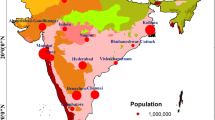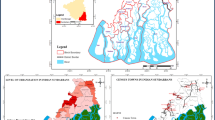Abstract
There is a worldwide growing concern that increased concentration of people are moving to cities. There are numerous studies that describe and explain this phenomenon. A limited amount of research focuses on specific autonomous urban environments. Evidence on land use and population density change examines Banjar Municipality, a new autonomous city, in Indonesia. Google Earth Image Series data, an appropriate solution for tracking land use change in smaller geographic areas, is examined between 2006 and 2016. Results show an increase in urban area from 13.49 to 15.41% while agricultural land decreased from 71.22 to 69.87%. Positive observational highlights indicate urban forested areas are minimally impacted by the Municipality’s city-wide development. A small percentage of the surrounding water bodies increased as a result of the local authority building a new artificial lake. Interestingly, urban area changes mostly have occurred throughout the districts of Banjar and Langensari, not in Pataruman, which has experienced the highest increase in population in the latter decade. The underlying research focalizes on the constraints to facilitate land use within an urban corridor setting.
Access this chapter
Tax calculation will be finalised at checkout
Purchases are for personal use only
Similar content being viewed by others
References
Huilei L, Jian P, Yanxu L, Yi’na H (2017) Urbanization impact on landscape patterns in Beijing City, China: a spatial heterogeneity perspective. Ecol Indic 82:50–60. https://doi.org/10.1016/j.ecolind.2017.06.032
Demographia (2018) Demographia world urban areas & population projections
World Bank (2016) Indonesia’s urban story
Prawatya NA (2013) Spatial development in small cities in Middle Java Province. J Wil Dan Lingkung 1:17–32
Ardiwijaya VS, Sumardi TP, Suganda E, Temenggung YA (2015) Rejuvenating idle land to sustainable urban form: case study of Bandung metropolitan area, Indonesia. Procedia Environ Sci 28:176–184. https://doi.org/10.1016/j.proenv.2015.07.024
Ruan X, Qiu F, Dyck M (2016) The effects of environmental and socioeconomic factors on land-use changes: a study of Alberta, Canada. Environ Monit Assess 188:466. https://doi.org/10.1007/s10661-016-5450-9
Long H, Heilig GK, Li X, Zhang M (2007) Socio-economic development and land-use change: analysis of rural housing land transition in the transect of the Yangtse River, China. Land Use Policy 24:141–153. https://doi.org/10.1016/j.landusepol.2005.11.003
Fang Y-G, Shi K-J, Niu C-C (2016) A comparison of the means and ends of rural construction land consolidation: case studies of villagers’ attitudes and behaviours in Changchun City, Jilin Province, China. J Rural Stud 47:459–473. https://doi.org/10.1016/j.jrurstud.2016.04.007
Li H, Yuan Y, Zhang X et al (2019) Evolution and transformation mechanism of the spatial structure of rural settlements from the perspective of long-term economic and social change: a case study of the Sunan region, China. J Rural Stud 1. https://doi.org/10.1016/j.jrurstud.2019.03.005
Yuan F, Wei YD, Chen W (2014) Economic transition, industrial location and corporate networks: remaking the Sunan Model in Wuxi City, China. Habitat Int 42:58–68. https://doi.org/10.1016/j.habitatint.2013.10.008
Potere D, Schneider A, Angel S, Civco DL (2009) Mapping urban areas on a global scale: which of the eight maps now available is more accurate? Int J Remote Sens 30:6531–6558. https://doi.org/10.1080/01431160903121134
Hadi F, Thapa RB, Helmi M, Hazarika MK (2016) Urban growth and land use: land cover modeling in Semarang, Central Java, Indonesia
Azam M (2019) Accounting for growing urban-rural welfare gaps in India. World Dev 122:410–432. https://doi.org/10.1016/j.worlddev.2019.06.004
Malarvizhi K, Kumar SV, Porchelvan P (2016) Use of high resolution Google Earth satellite imagery in landuse map preparation for urban related applications. Procedia Technol 24:1835–1842. https://doi.org/10.1016/j.protcy.2016.05.231
Sidhu N, Pebesma E, Câmara G (2018) Using Google Earth engine to detect land cover change: Singapore as a use case. Eur J Remote Sens 51:486–500. https://doi.org/10.1080/22797254.2018.1451782
Hu Q, Wu W, Xia T et al (2013) Exploring the use of Google Earth imagery and object-based methods in land use cover mapping. Remote Sens 5:6026–6042. https://doi.org/10.3390/rs5116026
Widyasamratri H, Aswad A (2017) A preliminary study: an agent-based spatial simulation of human-coastal environment interaction. In: The third international conference on coastal and delta areas, pp 593–601
Handayani W, Rudiarto I (2011) Dinamika Persebaran Penduduk Jawa Tengah: Perumusan Kebijakan Perwilayahan Dengan Metode Kernel Density. Diponegoro University
Held D, McGrew A, Goldblatt D, Perraton J (1999) Introduction in global transformations. In: Global transformations: politics, economics and culture. Stanford University Press, Stanford, pp 1–31
Panennungi MA (2013) Cost and benefit of globalization: lesson learned from Indonesian history
Yuniarto PR (2014) Globalization problem in Indonesia: between interest, policy and challenge. J Kaji Wil 5(29)
Kis-Katos K, Sparrow R (2011) Child labor and trade liberalization in Indonesia. J Hum Resour 46:722–749. https://doi.org/10.1353/jhr.2011.0008
Keohane RO, Nye JSJ (1998) The Oxford dictionary of quotations. Harvard University
Vujakovic P (2010) How to measure globalization? A new globalization index (NGI). Atl Econ J 38:237. https://doi.org/10.1007/s11293-010-9217-3
Rifai M (2017) Regional autonomy and globalization: a development model study in Karawang Regency. J Polit Indones 2:15–28
Stasavage D (2014) Was Weber right? The role of urban autonomy in Europe’s rise. Am Polit Sci Rev 108:337–354. https://doi.org/10.1017/S0003055414000173
Paierele O (2011) Globalization impact on the local and regional development policies: Republic of Moldova case
Myerson RB (2015) Democratic decentralization and economic development. In: The Oxford handbook of Africa and economics, pp 1–19. https://doi.org/10.1093/oxfordhb/9780199687114.013.18
Riadi B, Barus B, Widiatmaka et al (2018) Identification of flood area in the coastal region using remote sensing in Karawang Regency, West Java. In: IOP conference series: earth and environmental science
Darmawan R (2008) The practices of decentralization in Indonesia and its implication on local competitiveness. University of Twente
Rudy, Hasyimzum Y, Heryandi, Khoiriah S (2017) 18 years of decentralization experiment in Indonesia: institutional and democratic evaluation. J Polit Law 10:132–139. https://doi.org/10.5539/jpl.v10n5p132
Mauro L, Pigliaru F, Carmeci G (2018) Decentralization and growth: do informal institutions and rule of law matter? J Policy Model 40:873–902. https://doi.org/10.1016/j.jpolmod.2018.05.003
Ishak AF, Utomo TWW (2014) Decentralization policy and regional autonomy implementation in East Kalimantan. J Borneo Adm 6a:1–17. https://doi.org/10.24258/jba.v6i2.57
Miller MA (2009) Rebellion and reform in Indonesia: Jakarta’s security and autonomy policies in Aceh. J Curr Southeast Asian Aff 28(4):145–151. https://doi.org/10.1159/000118017
Miller MA (2013) Decentralizing Indonesian city spaces as new “centers”. Int J Urban Reg Res 37:834–848. https://doi.org/10.1111/j.1468-2427.2013.01209.x
Phelps NA, Bunnell T, Miller MA (2011) Post-disaster economic development in Aceh: neoliberalization and other economic-geographical imaginaries. Geoforum 42:418–426. https://doi.org/10.1016/j.geoforum.2011.02.006
Rodríguez-Pose A, Ezcurra R (2010) Does decentralization matter for regional disparities? A cross-country analysis. J Econ Geogr 10:619–644. https://doi.org/10.1093/jeg/lbp049
Ludwig A, Meyer H, Nauss T (2016) Automatic classification of Google Earth images for a larger scale monitoring of bush encroachment in South Africa. Int J Appl Earth Obs Geoinf 50:89–94. https://doi.org/10.1016/j.jag.2016.03.003
Qi F, Zhai JZ, Dang G (2016) Building height estimation using Google Earth. Energy Build 118:123–132. https://doi.org/10.1016/j.enbuild.2016.02.044
Burgess EW (2008) The growth of the city: an introduction to a research project. In: Urban ecology. Springer US, Boston, MA, pp 71–78
Shertzer A, Twinam T, Walsh RP (2018) Zoning and the economic geography of cities. J Urban Econ 105:20–39. https://doi.org/10.1016/j.jue.2018.01.006
Syaifuddin, Hamire A, Dahlan (2013) The relationship between and land use change in Somba Opu District, Gowa Regency. J Agrisistem 9:169–179
Li F, Zhang S, Bu K et al (2015) The relationships between land use change and demographic dynamics in western Jilin Province. J Geogr Sci 25:617–636. https://doi.org/10.1007/s11442-015-1191-x
Russo A, Cirella G (2018) Modern compact cities: how much greenery do we need? Int J Environ Res Public Health 15:2180. https://doi.org/10.3390/ijerph15102180
Brøgger D (2019) Urban diaspora space: rural-urban migration and the production of unequal urban spaces. Geoforum 102:97–105. https://doi.org/10.1016/j.geoforum.2019.04.003
Chen T, Lang W, Chan E, Philipp CH (2018) Lhasa: urbanising China in the frontier regions. Cities 74:343–353. https://doi.org/10.1016/j.cities.2017.12.009
Acknowledgements
The authors would like to acknowledge support from the China Scholarship Council, National Natural Science Foundation of China (Grant No: 41471103), West Java Province Government, and Banjar Municipality Government.
Author information
Authors and Affiliations
Corresponding author
Editor information
Editors and Affiliations
Rights and permissions
Copyright information
© 2020 Springer Nature Singapore Pte Ltd.
About this chapter
Cite this chapter
Supriyadi, A., Wang, T., Chu, S., Ma, T., Shaumirahman, R.G., Cirella, G.T. (2020). Urbanization and Population Change: Banjar Municipality. In: Cirella, G. (eds) Sustainable Human–Nature Relations. Advances in 21st Century Human Settlements. Springer, Singapore. https://doi.org/10.1007/978-981-15-3049-4_11
Download citation
DOI: https://doi.org/10.1007/978-981-15-3049-4_11
Published:
Publisher Name: Springer, Singapore
Print ISBN: 978-981-15-3048-7
Online ISBN: 978-981-15-3049-4
eBook Packages: Earth and Environmental ScienceEarth and Environmental Science (R0)




